Cacti, with their unique appearance and ability to thrive in arid environments, have long fascinated botanists, gardeners, and nature enthusiasts. These remarkable plants belong to the family Cactaceae and are renowned for their striking shapes, succulent stems, and spines. In this article, we will explore the captivating world of cacti, delving into their adaptations, diverse species, cultivation, and the intriguing role they play in arid ecosystems.
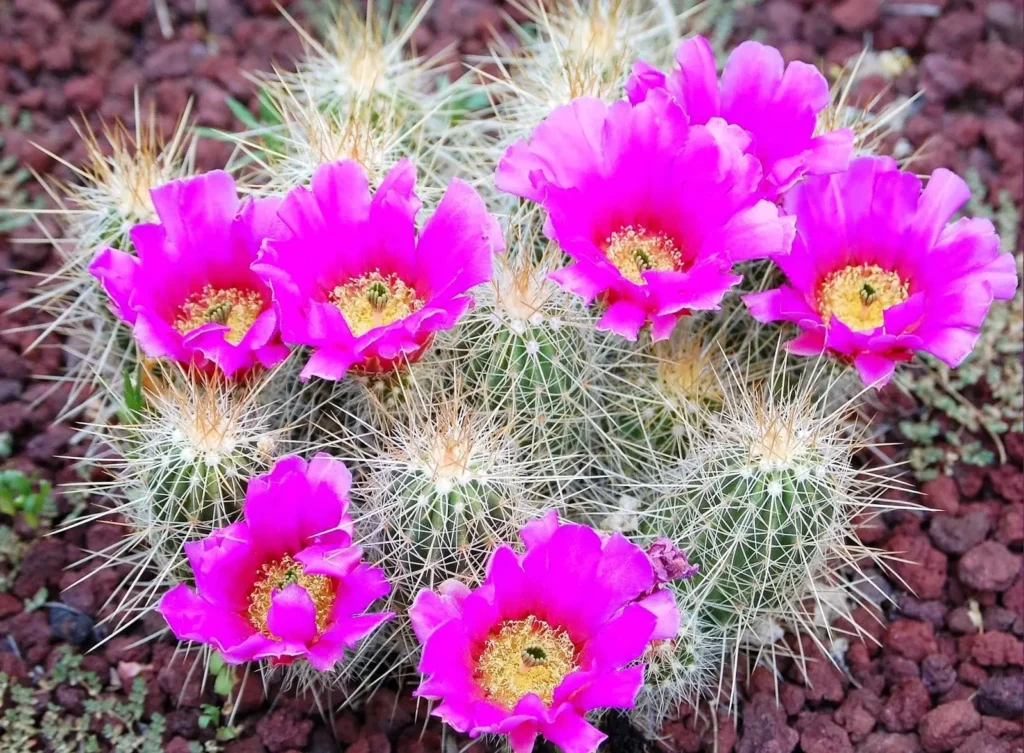
Adaptations and Unique Features
Cacti have evolved remarkable adaptations that allow them to survive in harsh desert conditions. Some key features include:
- Succulent Stems: Cacti possess thick, fleshy stems that serve as water storage reservoirs, enabling them to withstand extended periods of drought. These stems are capable of expanding to accommodate water storage when available and slowly releasing it during dry periods.
- Spines: The spines of cacti serve multiple purposes. They help to reduce water loss by creating a barrier that minimizes evaporation from the stem’s surface. Additionally, spines deter herbivores from feeding on the plants, protecting them from potential damage.
- Reduced Leaf Surface: To minimize water loss through transpiration, cacti have evolved reduced or absent leaves. Instead, photosynthesis occurs in the green stems, which contain chlorophyll and can convert sunlight into energy.
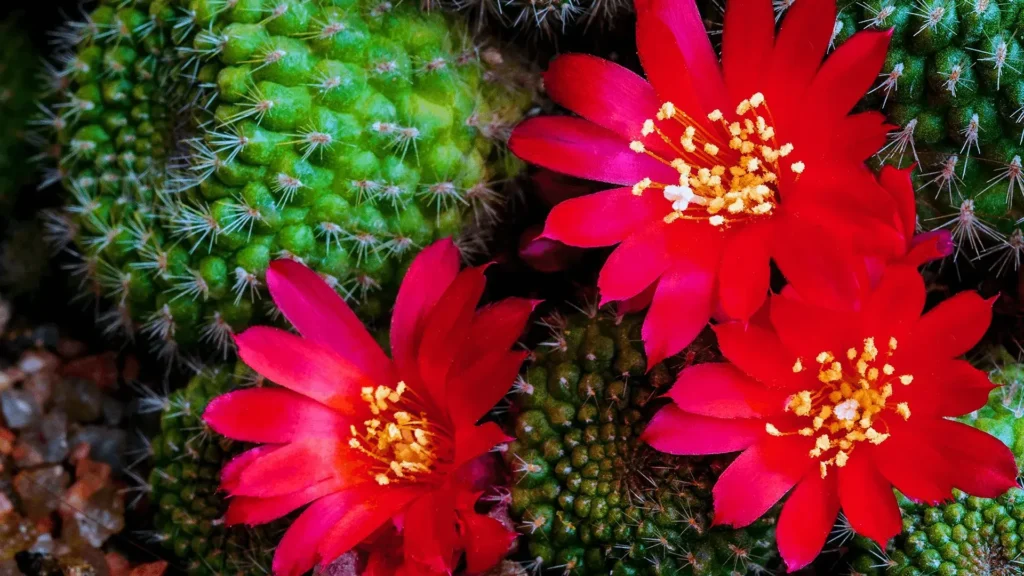
List of popular beautiful types of cactus flowers
Cacti are known for their fascinating and diverse array of flowers. While the majority of cacti produce flowers, the characteristics and colors can vary widely among different species. Here are a few notable types of cactus flowers that showcase the beauty and diversity of these plants:
- Night-Blooming Cereus (Epiphyllum oxypetalum): Also known as the Queen of the Night, this cactus species produces large, fragrant white flowers that bloom exclusively at night. The flowers have a delicate appearance with long, narrow petals and emit a captivating fragrance.
- Easter Lily Cactus (Echinopsis spp.): The Easter Lily Cactus is a group of cacti that produce stunning trumpet-shaped flowers. These flowers come in various colors, including shades of pink, yellow, orange, and white. They often have vibrant, contrasting stamens that add to their visual appeal.
- Rebutia (Rebutia spp.): Rebutia cacti are known for their charming and petite flowers. They typically produce small, bell-shaped blossoms in a range of colors, such as red, orange, pink, and yellow. Rebutia flowers often have intricate patterns or markings on their petals, adding to their allure.
- Hedgehog Cactus (Echinocereus spp.): Hedgehog cacti are characterized by their cylindrical stems covered in spines. Many species in this group produce colorful flowers that emerge from the top of the stem. The flowers can be large and showy, with vibrant hues of red, pink, purple, or yellow.
- Fishhook Cactus (Mammillaria spp.): Fishhook cacti are known for their hooked spines and charming flowers. These cacti produce small, round flowers that can come in various colors, including white, yellow, pink, or red. The flowers often have a delicate, daisy-like appearance.
- Old Lady Cactus (Mammillaria hahniana): The Old Lady Cactus is recognized for its distinctive white, hair-like spines and lovely pink or lavender flowers. The flowers are tubular in shape and have prominent stamens, giving them a striking appearance.
- Christmas Cactus (Schlumbergera spp.): While not a true cactus, the Christmas Cactus is a popular holiday plant that belongs to the cactus family. It produces beautiful, pendulous flowers in shades of pink, red, white, or purple. The flowers typically bloom in winter, making them a festive addition to seasonal decorations.
- Orchid Cactus (Epiphyllum spp.): Orchid cacti, also known as Epiphyllums, produce large, showy flowers with intricate shapes and vibrant colors. The flowers often have elongated petals and come in various shades of red, pink, orange, purple, and white. They are known for their striking beauty and can create a stunning display when in bloom.
- Barrel Cactus (Ferocactus spp.): Barrel cacti are known for their barrel-shaped bodies and eye-catching flowers. The flowers typically appear near the top of the cactus and are often bright yellow or orange in color. They have a star-like shape with numerous petals radiating from the center, creating a captivating display.
- Moon Cactus (Gymnocalycium spp.): Moon cacti are unique because they lack chlorophyll and rely on grafting onto another cactus for survival. These small cacti produce bright and vibrant flowers in shades of red, orange, pink, or yellow. The flowers are typically bell-shaped or cup-shaped and add a burst of color to the top of the cactus.
- Turk’s Cap Cactus (Melocactus spp.): Turk’s Cap cacti are known for their distinctively shaped flowers. The flowers form a cap-like structure on top of the cactus, which gives them their name. They are often brightly colored, with shades of pink, red, or purple. The cap is covered in small, hair-like structures, adding to their unique appearance.
- Prickly Pear Cactus (Opuntia spp.): Prickly Pear cacti produce vibrant and striking flowers. The flowers are usually large and come in various shades of yellow, orange, pink, or red. They have numerous petals and often bloom in clusters along the cactus pads, creating a breathtaking sight.
- Bishop’s Cap Cactus (Astrophytum spp.): Bishop’s Cap cacti are named for their distinctive shape, which resembles a bishop’s hat. These cacti produce eye-catching flowers that are typically yellow, sometimes with a touch of red or orange. The flowers have a star-like shape with multiple petals and add elegance to the plant.
- Queen of the Andes (Puya raimondii): While not a cactus in the strict sense, the Queen of the Andes is a stunning plant native to the Andean highlands. It produces a massive inflorescence with hundreds of small, pale green flowers that form a spectacular and imposing display.
These are just a few examples of the diverse cactus flowers found in the plant kingdom. Each type of cactus showcases its unique charm, color palette, and floral structure, providing a visual feast for admirers of these extraordinary plants.
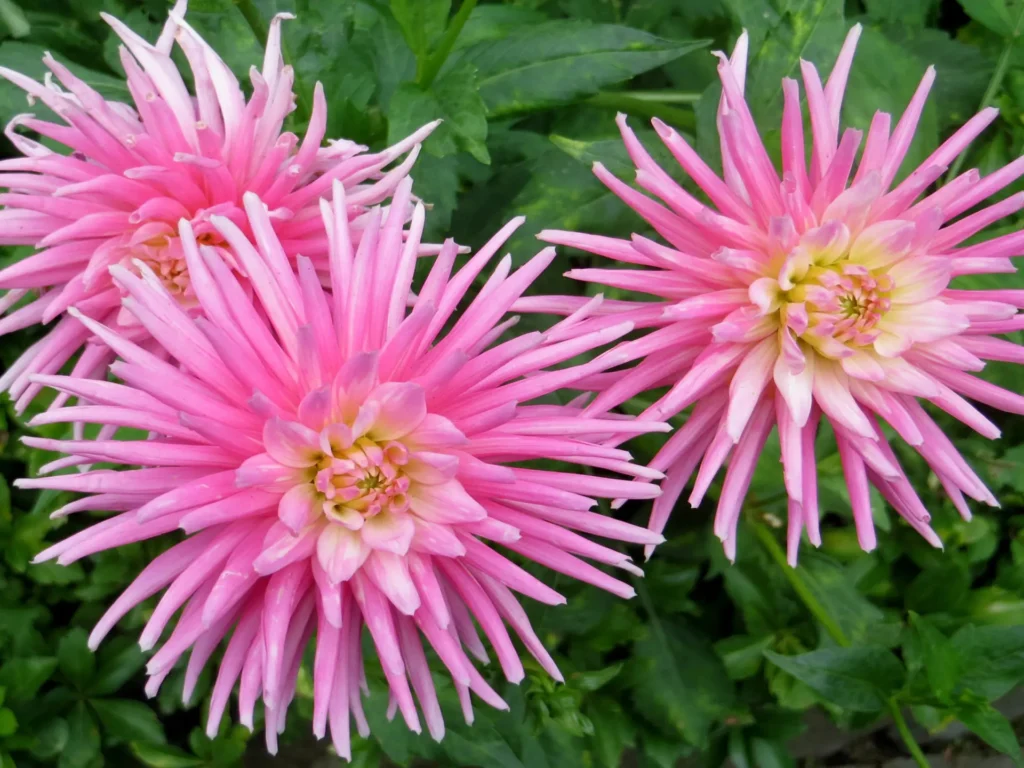
Cultivation and Care
Cultivating cacti can be a rewarding endeavor, both for indoor and outdoor settings. Here are some essential tips for their care:
- Light and Temperature: Most cacti require bright sunlight to thrive. Place them in locations with direct sunlight for several hours a day. Temperature preferences vary among species, but most cacti tolerate warm to hot climates.
- Watering: Cacti have low water requirements and are adapted to arid conditions. Allow the soil to dry out completely between waterings, and be cautious not to overwater, as excessive moisture can lead to root rot.
- Soil and Potting: Use well-draining soil specifically formulated for cacti. A mixture of sand, perlite, and potting soil works well. Ensure the pot has drainage holes to prevent waterlogging.
- Fertilization: Cacti generally have low nutrient needs. Use a balanced, water-soluble fertilizer diluted to half strength during the growing season.
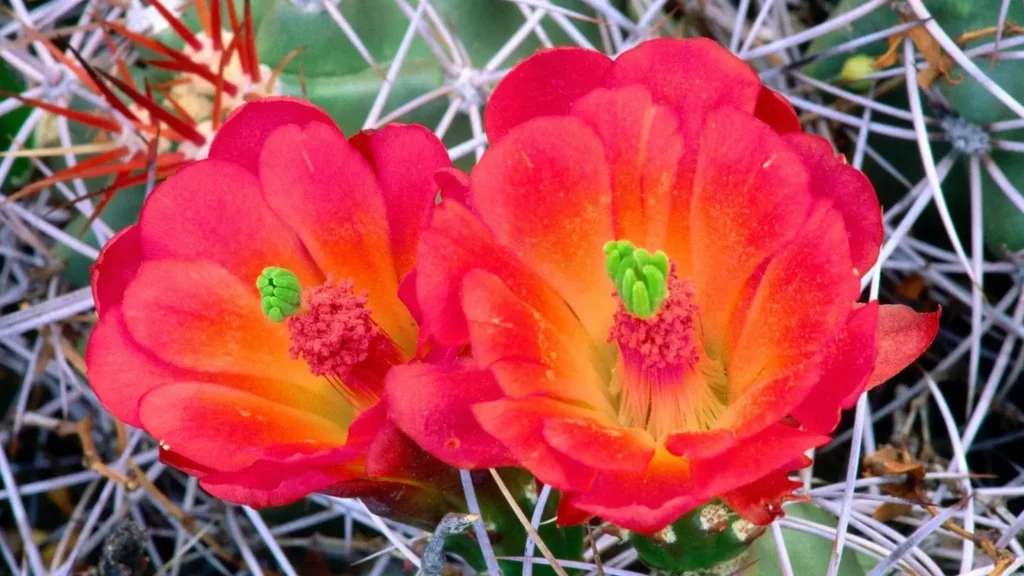
Ecological Significance
Cacti play a vital role in arid ecosystems. Their succulent stems provide water and nourishment to various animals, including insects, birds, and desert mammals. Additionally, their spiny structures offer protection and shelter to small creatures seeking refuge from predators.
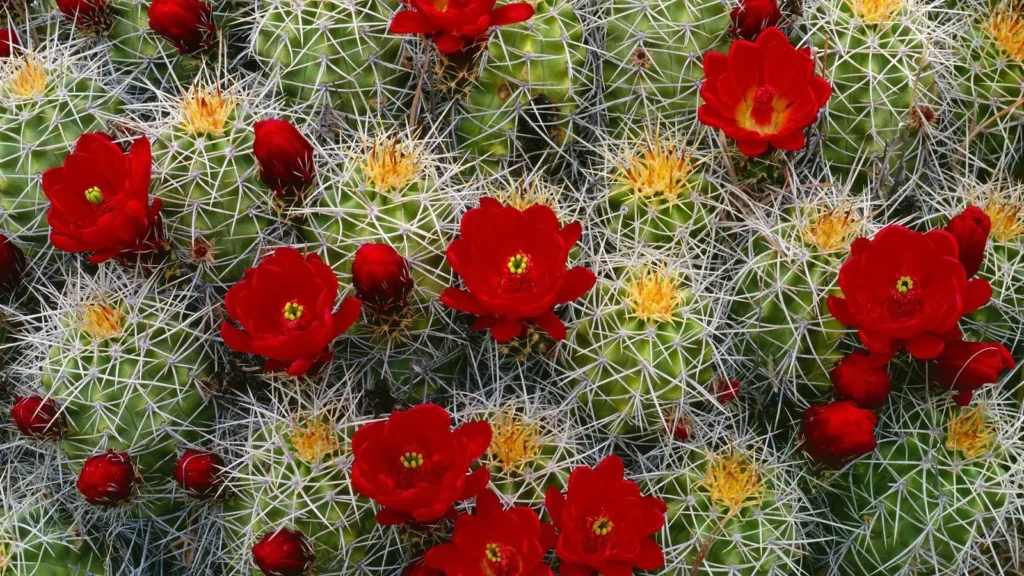
Cacti are marvels of the plant kingdom, showcasing remarkable adaptations and captivating forms. From their succulent stems to their spines and vibrant blooms, they have captivated the hearts of plant enthusiasts worldwide. By understanding and appreciating their unique characteristics, we can cultivate and conserve these extraordinary plants while marveling at their resilience and beauty in arid landscapes.
Types of the Cactus flower
Cacti are known for their unique and often stunning flowers that bloom from the prickly pads or stems of the plants. These flowers come in various shapes, sizes, and colors, and they often contrast beautifully with the cacti’s spiky appearance. Here is a list of cactus flowers from different cactus species:
- Saguaro Cactus (Carnegiea gigantea): The Saguaro cactus produces large, white flowers with a waxy texture. They usually bloom at night and are pollinated by bats.
- Golden Barrel Cactus (Echinocactus grusonii): This cactus features yellow flowers that emerge from the top of the plant’s spherical body.
- Prickly Pear Cactus (Opuntia spp.): Prickly pear cacti produce vibrant yellow, orange, or red flowers that are often followed by edible fruits called “prickly pears” or “tunas.”
- Hedgehog Cactus (Echinocereus spp.): Hedgehog cacti have bright-colored flowers that vary from pink and red to yellow and orange.
- Barrel Cactus (Ferocactus spp.): Barrel cacti produce funnel-shaped flowers in shades of red, pink, yellow, or orange.
- Easter Lily Cactus (Echinopsis spp.): These cacti are known for their large, showy flowers that come in various colors, including white, pink, and red.
- Night-Blooming Cereus (Epiphyllum oxypetalum): Although technically an epiphytic cactus, the Night-Blooming Cereus produces large, fragrant, white flowers that bloom at night.
- Fishhook Cactus (Sclerocactus spp.): Fishhook cacti bear colorful flowers that are often cup-shaped and come in shades of pink, purple, or yellow.
- Rainbow Hedgehog Cactus (Echinocereus rigidissimus): This cactus species produces vibrant, tubular flowers that range in color from red and orange to pink and magenta.
- Christmas Cactus (Schlumbergera spp.): While not a true desert cactus, the Christmas cactus is known for its colorful, tubular flowers that bloom around the holiday season.
- Queen of the Night (Selenicereus grandiflorus): Another night-blooming cactus, the Queen of the Night produces large, white, fragrant flowers that open after sunset.
- Crown Cactus (Rebutia spp.): These small cacti produce dainty flowers that come in various colors, often with intricate patterns or markings.
- Peyote (Lophophora williamsii): Peyote cactus produces small, pinkish-white flowers that emerge from the center of the cactus. It’s known for its psychoactive properties and is culturally significant to certain indigenous groups.
- Beavertail Cactus (Opuntia basilaris): The beavertail cactus gets its name from its flat, oval pads that resemble a beaver’s tail. It produces vivid magenta or pink flowers.
- Echinopsis chamaecereus (Peanut Cactus): This cactus produces charming flowers that are often bi-colored, with a darker outer petal color and a lighter inner petal color.
- Rebutia muscula: The Rebutia genus includes many species with vibrant flowers. Rebutia muscula, for instance, produces small, star-shaped flowers in various colors.
- Mammillaria spp. (Pincushion Cacti): Mammillaria cacti produce colorful flowers atop their rounded bodies. Flower colors can range from white and yellow to pink and red.
- Echinocereus triglochidiatus (Claret Cup Cactus): This cactus is known for its brilliant red to orange-red flowers that resemble cups or goblets.
- Parodia spp. (Ball Cacti): Parodia cacti are spherical and produce large, colorful flowers. The flowers often have a distinct pattern or design.
- Turk’s Cap Cactus (Melocactus spp.): These cacti are characterized by their distinctive “hats” or cephalium, which produce colorful flowers that emerge from the top.
- Ariocarpus spp. (Living Rock Cacti): These cacti are known for their unique appearance, resembling rocks with clefts. They produce small, star-shaped flowers.
- Selenicereus anthonyanus (Fishbone Cactus): While not a traditional desert cactus, the Fishbone Cactus produces stunning night-blooming flowers with a unique shape that resembles fish bones.
- Echinocactus grusonii (Golden Barrel Cactus): In addition to its impressive golden spines, this cactus produces yellow flowers that add to its visual appeal.
- Epiphyllum spp. (Orchid Cacti): Epiphyllum cacti produce large, showy flowers in various colors. The flowers often have a lovely fragrance.
- Ferocactus wislizeni (Candy Barrel Cactus): This cactus produces large, funnel-shaped flowers in shades of yellow, orange, or red.
These are just a few examples of the diverse and beautiful cactus flowers you can find across different cactus species. Each cactus flower has its own unique characteristics and adds to the allure of these fascinating desert plants.








